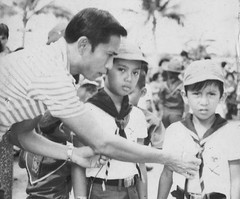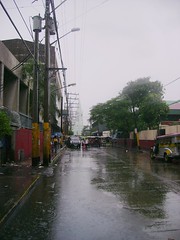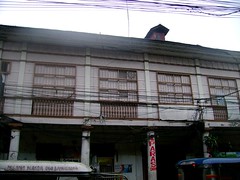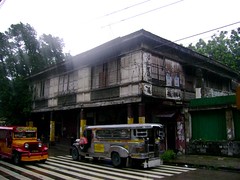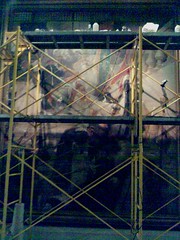 [/caption]
[/caption]The masterpiece is currently undergoing some delicate repainting. Time has eroded some of the pigments out of the canvas and preservation is needed to prevent deterioration. I remember the exhibitions of Lopez Museum, they did impress me with their preservation technology. They hired top rate chemist and employed good artist to do the maintenance and repair for the damaged old paintings. They have a very technical systemized way that i thought was awesome, there was a visual presentation that showed how they were able to achieve it.
Are they exchanging technologies? is the private supporting the government run museums? I hope coordination is working well with this institutions for the benifit of the public.
In Museo Nacional, I'm quite unsure how the preservation is done. No one has entertained my questions, in fact, they were quite dismissive when they found out that I was just a nobody, the man on the site just stopped talking to me, that was my cue - I was on my own.
Unlike the private ones, the museum of course is a government institution - and we all know how government institution functions in our country. I put my trust on the skill of the artist who I'm certain volunteered to work for the museum to help, if their getting paid I'm certain that their not getting much. Its noble ambition of keeping the art alive, especially the work of our renowned patriots in Hidalgo and Luna. I was once invited to join the MVP (volunteers) but was unable to make it due to my partime work and college.
But let me say this, I am very satisfied with the improvements made on the museum. If only money can be poured for the museum I'm certain that our national museum would even become better. Kudos goes to the administrators.
Interestingly enough, when i was there in the Hidalgo painting - the students where asking 'who was being murdered' after trying to observe the painting behind the scaffolds. It looks like their teachers did not read materials related to the painting in advance, someone failed to do their homework - after all this two artwork ('assasination of Bustamante' & 'spolarium') are the centerpiece of the museum. To my shock, one of the student leader, while the group was viewing Hidalgo's work, said to his group 'this is how Spain tortured those who opposed them when we were under their kingdom'. I was about to call 'security' at that time but restrained myself.
That painting tells a great but tragic story, a man who tried to straightened out the government and rid it with grafters, who in the end was accused of being corrupt himself, accused of being a despot who was overthrown by the righteous majority. On top of his tough policy on collections, he locked horns with the powerful friars. Which was his undoing.
Martin de Zuniga's book 'Historical View of the Philippines' gives us this short account of what took place, and how 'El Marcial' got lynched by the mob friars.
'...He began by issuing some strong decrees, and others still more severe were expected. These were principally directed to teh recovery of the above two hundred thousand dollars. Which he found were due to the royal treasury by different people,both by those in office, and generally by the public. These parties finding he was determined on the measure, began to murmur at his proceedings. Without, however, allowing himself to be influenced by any consideration of this nature, he laid an embargo on all silver that came in the galleon from Acapulco, and required from all the public functionaries correct statements of their accounts with the royal treasury. By an examination of those names which appeared as owners of the silver, he found it an easy matter to cover all those debts, and by this dexterous management recovered about three hundred thousand dollars to the treasury. Many of those, however, then indebted to the government, having died, or being reduced to poverty, their securities of course became responsible and this extend the consequences of his measures to so many in Manila, that he became an object of general hatred..'
As can be read, he was a determined administrator who not only offended the evaders but also some of the more high ranking corrupt official with their ill gotten wealth. Confiscation and imprisonment is his way of bringing justice. He single handled swept out the biggest grafters of his time.
So why is it that Friars are the one depicted murdering 'El Marcial'?
The story continues with the Oidor Torralba trying to arrest a man who sought refuge in the cathedral.
'...the Archbishop, convinced that Senor Torralba was the principal instigator of these unhappy disputes, with less prudence than the circumstances of the times required, issued a process against this violator of ecclesiastical sanctuary, and excommunicated him. This is the grand error he committed, and from which melancholy consequence resulted; for having sent two clergy to intimate to him the sentence of excommunication, Torralba, on observing them approach, went to meet them, and snatched from them the paper containing it. Immediately afterwards appeared in publication from him accusing the clergy of an intention to take his life, and suborned witnesses: having confirmed this charges, the Governor was induced to commit to prison the Archbishop, and several of the clergy and religious orders, with such other persons as had taken refuge in the churches.
Having thus made his dispositions, the Governor ordered the Archbishop, with all the ecclesiastical Cabildo, the Commisarry of the Inquisition, the heads of the religious orders, and various other clergy, to be seized...'
Of course the event that follows is obvious - its the scene that Hidalgo made immortal in his canvas. Bustamante's display of power backfired and the offended party fought back, ironically the people who returned his violence were the men of clothe.
'Leave me Father, unless you wish to murder me!' he cries, when the friars where already on his doorsteps. He broke his arm defending the attacks, his head severely wounded, he fell dead. His son tried to help him, with saber in his hand he gallantly defended his small space, but the mob was too much for his young body. He died with his father that day. The son cried, 'Father, do not abandon me until the last moment of my life...' a Jesuit priest was said to have given him his last confession. He was still alive, this time fighting to survive, being carried out in a hammock when a man came stabbed him twice.
The Archbishop was persuaded to take the governorship, he declined after his released from the Fort Santiago. He later assumed the post as an administrator but not as the governor, similar to that of an OIC, he then threaded cautiously in his administration, for he was well aware of the danger of his post. He then ordered the proper burial for the murdered governor, with all the honors accorded to the highest post in the land. The Archbishop ruled for two years, in those years he was technically the Governor of the islands minus the uniform.
Now, how is that for a Coup de Etat! we are accustomed seeing this venture being undertaken by an adventurist military and collaborating politicians. A great piece of our history - just an example how people at high places can be dislodged by the potent combination of power grabbing forces, the church, and the masses.
History does repeat itself.
I just hope those students would continue their studies in history even if they pursue courses in college not related to it, books are always available. What is rare this days are open minds.
